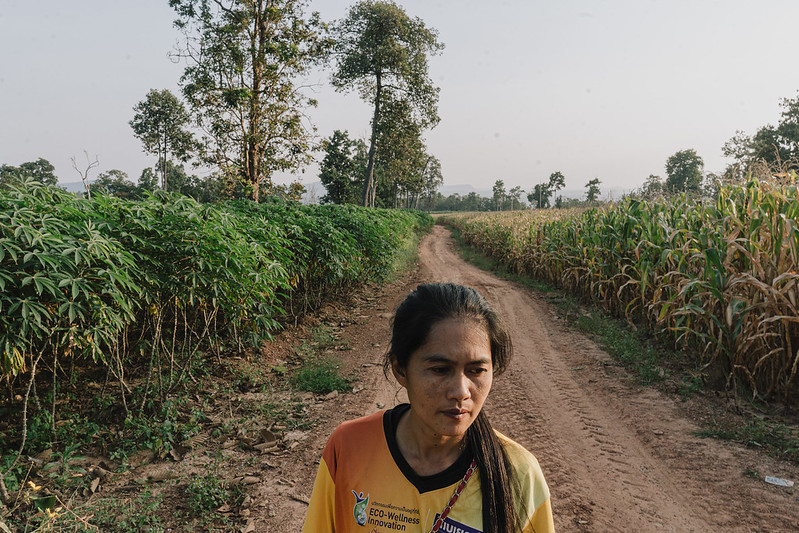SPECIAL SERIES: SWEETNESS & POWER
Some foreigners visiting Thailand are dismayed by how much sugar Thais scoop onto their food and say how sweet Thai food is. But much of the sugar added to food in Thailand is visible.
These dismayed foreigners would be surprised at how little sugar Thais eat on average and just how much they are consuming back in their home countries.
In this Part III of our series on Sweetness & Power, The Isaan Record examines how a peculiar grass called sugarcane, has evolved from once was a spice into a type of “food,” and insinuated itself into our cultures and our waistlines.
PART III: Dire costs of the human sweet tooth
This past year, people worldwide consumed an average of 23,000 grams of sugar–in their coffee or milk tea or candy, or in their beverages, or hidden in the processed foods they ate. That’s the same as putting 15 and a half teaspoons of sugar in your mouth every day.
With so much sugar let loose on the world, it has become part of us as it may make up as much as 20 percent of the total caloric intake of the modern diet. The other 80 percent of the diet has to be even more nutritious to make up the difference of the empty calories of sugar.
Filling yourself on sugar can appease a craving but leave your body starving.
The World Health Organization (WHO) recommended in 2015 that sugar as a percent of total caloric intake should be reduced to at least not more than 10 percent and ideally, only 5 percent. The American Heart Association (AHA) recommends male adults consume no more than nine teaspoons a day, and females not more than six, an average of 31.5 grams.
How many footballs of pure sugar do you eat every year?
But the world is eating a lot more sugar than it should. If thinking about annual per capita sugar consumption in the form of footballs made completely of white sugar, Americans top the list, eating ten footballs of sugar through the course of a year. That is 400 percent more than what the AHA recommends. Canadians eat seven sugar footballs, Saudis six and a half, and the world average is five which is twice as much as the AHA recommends.

The WHO would rather have you eat at the very most four footballs of sugar, but it would ideally like you to stick to just two.
In Asia, Japan’s at the top with four and a half footballs of sugar a year. In Southeast Asia, Singapore and Malaysia come in at the top with two and one-half footballs, while Thais have only a modest 2.32 sugar footballs annually.
Surprisingly, perhaps, the Philippines and Indonesia already consume less than the WHO’s more stringent recommendation. Sugar-deprived Indians gets less than half a football of sugar a year.

Source: The Washington Post
Americans are laying off more of sugar, but corn syrup still a problem
The diet of people in the United States was transformed when high fructose corn syrup (HFCS) and other corn sweeteners began pouring into the American body. US cane sugar consumption peaked in 1972 when the average American ate 46.5 kilograms of it. Sugar consumption peaked in 1999 when Americans per capita gobbled down 69 kilogram– 55 percent of it was corn sweeteners, 44 percent cane sugar, and 1 percent honey and maple syrup.
By 2017, overall US cane sugar consumption had dropped by a third since the peak year of 1972 (although when compared with 1999, sugar cane consumption had actually increased by ten percent).
Health concerns about sugar, and HFCS in particular–such as a link between HFCS and the prevalence of diabetes–caused Americans to consume a third less of HFCS and other corn sweeteners in 2017.
To allay consumer fears, many fast food restaurants such as McDonalds have replaced HFCS with sugar. Public health experts are concerned about added HFCS and other sources of fructose can affect world diets.

Source: United States Department of Agriculture and adapted from Bloomberg
Sugar consumption, obesity, and diabetes–and happiness
It’s not hard to find studies linking increased sugar intake, either directly or indirectly, with rising levels of obesity, diabetes, and other various health risks.
The World Health Organization warns that obesity rates have tripled in the last four decades. It estimates that 39 percent of the world population is overweight and 13 percent are obese. During the same period, obesity rates for those aged five to 19 years of age has risen from four per cent to 18 percent.
WHO points out the relationship between being overweight or obese and the consumption of “engergy-dense foods that are high in fat” and the increasingly “sedentary nature” of modern life. In short, more calories are consumed than expended, putting a large percentage of the world’s population at risk of heart disease, diabetes, degeneration of joints, and cancer.

Source: Adapted from Sugar-Sweeterner-Guide
One group of scholars have argued that except for the profits reaped by the sugar industry, the “main output” of all this sugar is “a global public health crisis” whose grip “is stronger than comparable scourges like tobacco, or even alcohol.”
Many studies have shown clear links between sugar intake and diabetes globally. But advocates for the sugar industry are quick to point out that overall sugar consumption has levelled off in some countries and even been reduced, such as in the United States. Sugar has a role in the diet, and your diet affects your health, but there are too many other factors to simply single out sugar as the main culprit of the world’s health crisis.
And indeed, as the table below shows, there is no easy correlation between sugar consumption, fat intake, diabetes, obesity, quality of life, life expectancy, or even “happiness,” other than to note that the ten out of the eleventh biggest per capita consumers of sugar appear also to be the happiest.

The top ten of in each category of these selected countries are marked green. Sources: daily sugar intake, daily fat intake, diabetes, obesity, quality of life, happiness, life expectancy
A crisis of sugar?
Some experts have suggested that overconsumption of sugar can have a toxic effect–effectively, serve as a poison in your system–and one study has argued that adding sugar can “lead to habituation and even in some cases addiction” with the surge of dopamine produced.
The human search for sweetness continues. If sugar consumption has too many health risks, a whole new industry has emerged in artificial, high-intensity sweeteners (HIS)–worth about USD two billion in 2017 according to an industry expert, and is predicted to reach, along with natural HIS, as much as USD three billion by 2022.
If trends continue, these sweeteners could be a real competitor to the sugar industry. In 2016, 146,000 tons of artificial, high-intensity sweeteners were produced globally, with the equivalent sweetness of 21 million tons of sugar–more than 10 percent of the real sugar produced worldwide in 2017.
A 2017 industry report lays out a strategy to highlight the health issues surrounding sugar consumption as a way of leveraging HIS: “Growing concerns regarding obesity and the connection between diet and major diseases such as diabetes and heart disease have caused consumers to reexamine their diets and lifestyles and seek healthier alternatives, including low- or no-calorie versions of food and beverages.”
As a result, the report goes on, “National and local governments see the diabetes epidemic as a public health issue and many are considering taxes on soft drinks as a means of fighting obesity. High-intensity sweeteners enable food producers to deliver reduced-calorie products that taste good.”
But the long-term health risks of even consuming HIS are still unclear. Two study hints that HIS as a sweet alternative fix may not reduce the chances of developing diabetes or reducing obesity.
In the first three segments of this series, The Isaan Record has examined the rise of sugar in modern society.
On one side of the ledger, sugar has the benefits of tasting really good, providing a livelihood to millions of cultivators, creating huge profits for the sugar industry as well as fertilizer and pesticide/herbicide companies.
That’s a lot of human activity concentrated around an empty carbohydrate that takes up the space where nutrition might, for a carbohydrate that is in many ways not even a food.
On the other side of the ledger, most sugarcane cultivation as presently practiced has had serious negative effects on soil quality, water supplies, water quality, ocean and riverine ecosystems, and air quality. On the person, body level of humans, the introduction of huge amounts of sugar into the body has been an unmitigated disaster and is connected to many of the chronic maladies now facing human society.
In the following segments of the series, The Isaan Record will bring you stories on the history of sugar in Thailand and Isaan, recount experiences of sugarcane growers in the region, take a look at honey and bees, provide some editorials written by those advocating changes in government policy, and end the series with an analysis and recommendations.





